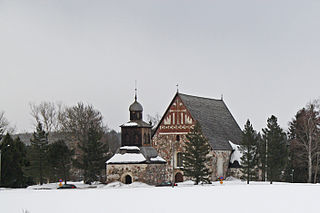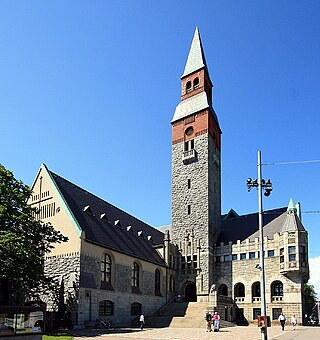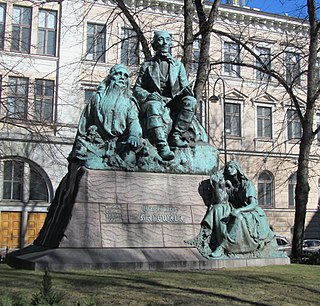
Helsinki is the capital, primate, and most populous city of Finland. Located on the shore of the Gulf of Finland, it is the seat of the region of Uusimaa in southern Finland and has a population of 665,558. The city's urban area has a population of 1,268,296, making it by far the most populous urban area in Finland as well as the country's most important center for politics, education, finance, culture, and research. Helsinki is located 80 kilometres (50 mi) north of Tallinn, Estonia, 400 km (250 mi) east of Stockholm, Sweden, and 300 km (190 mi) west of Saint Petersburg, Russia. It has close historical ties with these three cities.

Savonlinna is a town and a municipality of 32,108 inhabitants in the southeast of Finland, in the heart of the Saimaa lake region, which is why the city is also nicknamed the "Capital of Saimaa". Together with Mikkeli, it is one of the largest towns in the South Savonia region and one of the concentrations in the region's hospital districts. The town is internationally known for its medieval St. Olaf's Castle and the annual Savonlinna Opera Festival. Its surrounding the enclaved municipality of Enonkoski.

Sipoo is a municipality of Finland. It is part of the Helsinki metropolitan area. The municipality has a population of 22,350 (28 February 2023) and covers an area of 698.60 square kilometres (269.73 sq mi) of which 358.97 km2 (138.60 sq mi) is water. The population density is 65.81 inhabitants per square kilometre (170.4/sq mi). The administrative center of the municipality is Nikkilä, which is located 34 kilometres (21 mi) northeast of the center of Helsinki. Another significant urban area is Söderkulla, located in the southern part of the municipality.

Kotka is a city in the southern part of the Kymenlaakso province on the Gulf of Finland. Kotka is a major port and industrial city and also a diverse school and cultural city, which was formerly part of the old Kymi parish; later, Kymi with the Haapasaari island and Karhula, the latter of which once separate from Kymi as the market town, were incorporated into Kotka. The neighboring municipalities of Kotka are Hamina, Kouvola and Pyhtää. Kotka belongs to the Kotka-Hamina subdivision, and with Kouvola, Kotka is one of the capital center of the Kymenlaakso region. It is the 19th largest city in terms of population as a single city, but the 12th largest city of Finland in terms of population as an urban area.

Arabianranta, sometimes simply Arabia, is a residential part of Helsinki, Finland. It is bound by Vanhankaupunginlahti bay from east, and connects to neighboring boroughs of Vanhakaupunki in north, Hermanni in south and Toukola and Kumpula in west. It is part of the greater Toukola region.

Hietalahti is the southernmost section of the Kamppi neighborhood the city of Helsinki, Finland. A notable feature is the Hietalahti shipyard.

Esplanadi, colloquially known as Espa, is an esplanade and urban park in downtown Helsinki, Finland, situated between the Erottaja square and the Market Square. It is bordered on its northern and southern sides by the Pohjoisesplanadi and Eteläesplanadi streets, respectively. Aleksanterinkatu runs parallel to Esplanadi. Esplanadi is well known as a popular walking area, and street performances are also often held in the park.

Ateneum is an art museum in Helsinki, Finland and one of the three museums forming the Finnish National Gallery. It is located in the centre of Helsinki on the south side of Rautatientori square close to Helsinki Central railway station. It has the biggest collections of classical art in Finland. Before 1991 the Ateneum building also housed the Finnish Academy of Fine Arts and University of Art and Design Helsinki.

Nosturi was a culture and music hall and a nightclub in the Punavuori district of Helsinki, Finland. It was owned by the Association of Live Music.

The National Museum of Finland presents Finnish history from the Stone Age to the present day, through objects and cultural history. The Finnish National Romantic style building is located in central Helsinki and is a part of the Finnish Heritage Agency, under the Ministry of Culture and Education.

Amos Rex is an art museum named after the publisher and arts patron Amos Anderson and located in Lasipalatsi, on Mannerheimintie boulevard in Helsinki, Finland. It opened in 2018 and rapidly reached international popularity, attracting more than 10,000 visitors in a matter of weeks.

Finnish art started to form its individual characteristics in the 19th century, when romantic nationalism began to rise in the autonomous Grand Duchy of Finland.

Marko Vuokola is a Finnish conceptual artist. He lives and works in Helsinki, Finland.

Aktiebolaget Sandvikens Skeppsdocka och Mekaniska Verkstad was a Finnish shipbuilding and engineering company that operated in Helsinki in 1895–1938. The company was set up to continue shipbuilding at Hietalahti shipyard, after its predecessor Helsingfors Skeppsdocka, which operated the yard in 1865–1895, had bankrupted.
Sinebrychoff were a Russian-Finnish business family, founders of the Sinebrychoff brewery and soft drinks company, and of the Sinebrychoff Art Museum.

Elias Lönnrot is a monument in Helsinki, the capital of Finland, by a Finnish sculptor Emil Wikström, unveiled in 1902.

Keisarinnankivi is a monument located at the Market Square in Kaartinkaupunki in central Helsinki, Finland. The monument, designed by Carl Ludvig Engel, is the oldest public monument in Helsinki. It was revealed with celebrations on the name day of Nikolai on 18 December 1835 to commemorate the first visit to Helsinki by Empress Alexandra Feodorovna, wife of Emperor of Russia Nicholas I. The monument was erected at the spot where the imperial couple stepped ashore from the steamship Ischora on arrival in Helsinki on 10 June 1833. The monument was funded by a national collection of funds and by a grant given by the Imperial Senate of Finland.

Hietalahdenranta is a street in the southern part of the centre of Helsinki, Finland. Like the entire Hietalahti area, the street belongs to the districts of Kamppi and Punavuori.

Lyhdynkantajat is a group of sculptures at the front door of the Helsinki Central Station in Helsinki, Finland. The sculptures were designed by Emil Wikström and completed in 1914. Lyhdynkantajat is part of the facade of the Art Nouveau station designed by Eliel Saarinen.


















